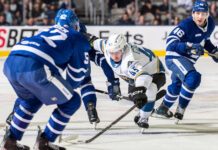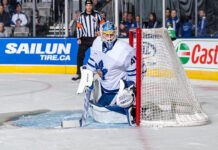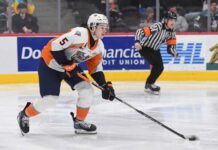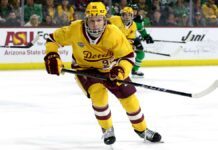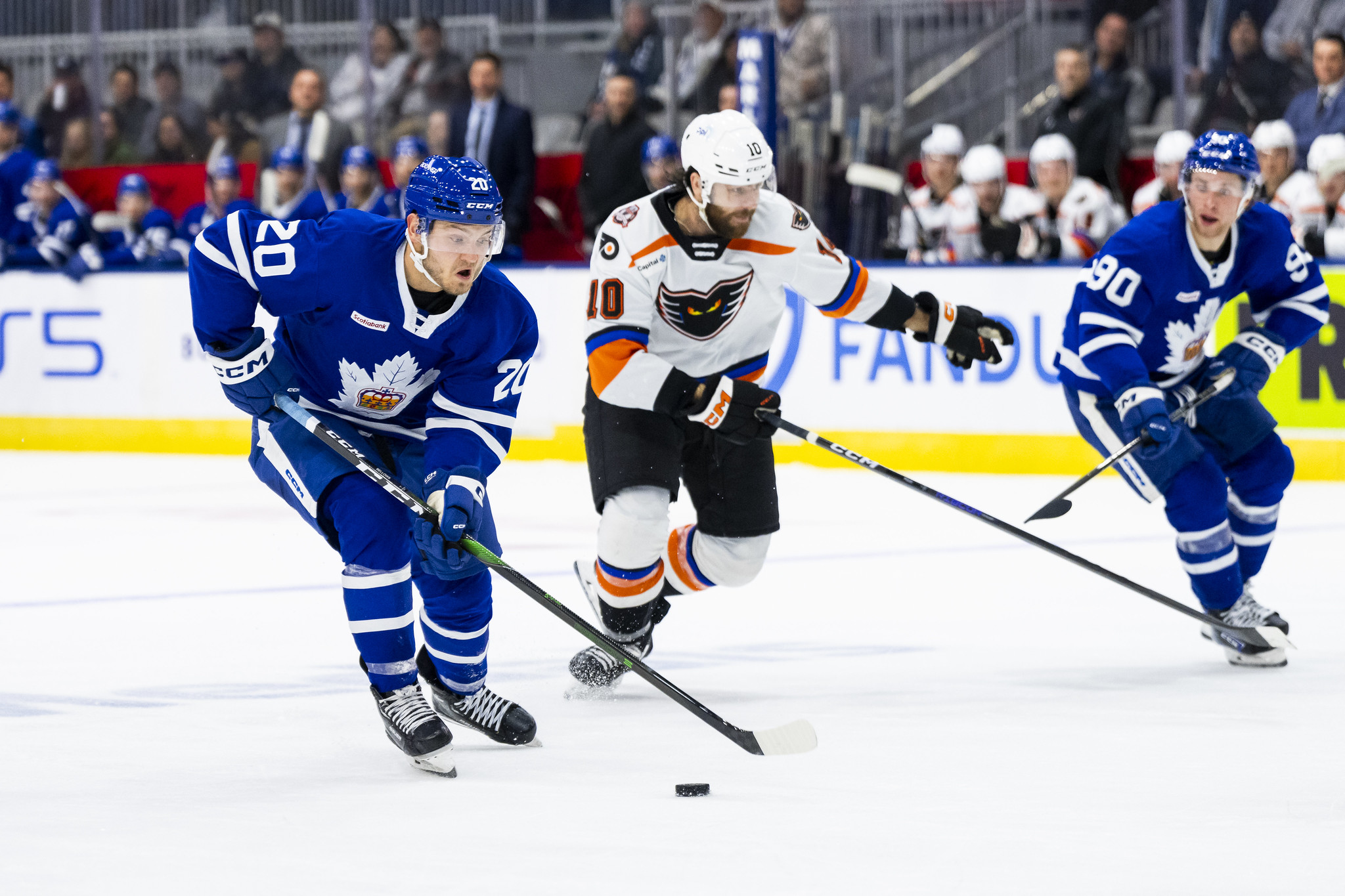The Toronto Marlies reached the midway point of their 2023-24 in Cleveland on the recent Boat Show road trip, and after a 2-1-0 stretch before the All-Star break, they currently sit at 19-14-6 (tied for third in the North Division).
Let’s start with the positives.
Toronto’s special teams have improved notably, with a top-10 penalty kill that has given up just 24 goals in 41 games, the fourth fewest in the league. Since joining the staff, Rich Clune has done a stellar job turning around the faltering power play, nudging it up near the middle of the pack at 17.8%.
After falling apart at critical moments during a seven-game losing streak, Toronto has shown some steel in its performances in recent weeks, fighting through adversity (sometimes self-induced) to take points from situations they wouldn’t have earlier in the campaign.
Despite enduring losing streaks, the Marlies have dominated long stretches of games at five-on-five, even against high-quality opposition. Toronto went toe-to-toe with league-leading Hershey and outplayed them at even strength despite ultimately falling to an overtime defeat.
Taking the statistics out of the equation, the level of goaltending on a nightly basis has been above average despite a lack of North American experience between the pipes.
On the flip side, spotting the opposition multi-goal leads, conceding quick goals against after scoring, and defensive breakdowns have hampered the Marlies’ ability to consistently string together positive results.
That propensity to find different ways to lose has seen Toronto lose by a single goal on 14 occasions this season. We can tack on a few more if we include two-goal losses with an empty-net goal against. An overtime/shootout record of 4-8 is not helping matters, either, but the only team with fewer wins than the Marlies‘ five in one-goal games is the San Jose Barracuda (four), who are ranked 29th in the league standings.
Toronto is in a battle to make the post-season despite a recent good run of form (5-2-2). They sit third in the North Division with only three points separating Toronto from Utica in seventh.
With 77% of their remaining schedule against North Division opponents, Toronto’s fate is in their own hands. That said, one of the major obstacles facing the Marlies this season is their terrible 5-10-7 record against division rivals. Without a victory in nine combined games against Cleveland and Syracuse (who are ranked first and second), they will face those opponents seven more times before the conclusion of the regular season.
In summary, it’s been a frustrating up-and-down season for the Toronto Marlies, but it’s not without some positive developments at various positions and for several players.
I’ve determined my grades with the following factors in mind: Level and consistency of performance, coupled with utilization and linemates; my expectations for the player and whether they’ve shown development in specific facets of their game, and I’ve also set a minimum of 10 games played to provide a grade.
With the disclaimers out of the way, let’s jump into the mid-season grades.
A+
Kieffer Bellows (18G/14A/32P in 34 GP)
Toronto Marlies GM Ryan Hardy pulled the proverbial rabbit out of the hat with this signing. Initially inked to a PTO, Bellows made an instant impact by rattling off an eight-game point streak that included six goals.
A dip in his performance following that electric start was a worrying sign, but John Gruden’s history with the player from their time together in the Islanders organization has helped the cause. The Marlies head coach called his player out privately and publicly, stating that he had strayed from the type of game that makes the 6’1, 195-pound winger most effective.
That message resonated as Bellows got back to basics and put in the work, responding with a six-game point streak that he hasn’t looked back from. The reward of an AHL contract has not slowed his production, especially at five-on-five. Bellows is fourth in AHL point production (26) and his 17 five-on-five goals lead the entire league.
The 23-year-old’s chemistry with rookie Ryan Tverberg has been a big part of the Marlies’ turnaround recently.
Pontus Holmberg (6G/4A/10P in 11 GP)
11 games in the AHL for Pontus Holmberg were 11 too many. Caught up in the numbers game — and frankly, some strange decision-making by management at the NHL level out of training camp — Holmberg did not sulk. Instead, he showed Sheldon Keefe et al. where he belonged with dominant performances at the AHL level.
Ryan Tverberg (8G/18A/26P in 26 GP)
Ryan Tverberg is scoring at a rate we haven’t seen consistently from a Marlies rookie since Connor Brown and William Nylander in 2014-15. I have no desire to make any unnecessary comparisons; rather, it provides context to the fantastic start to Tverberg’s professional career.
After a strong start to the season (four points in five games), Tverberg suffered a lower-body injury that kept him out of the lineup for six weeks. He hasn’t missed a beat since returning, scoring at a point-per-game pace that is only usurped on the team by Alex Steeves.
After starting on the wing, John Gruden shifted Tverberg to center due to necessity. The rookie has since earned the trust of the coaching staff to continue plying his trade down the middle.
The standout attributes of Tverberg’s game are his unmatched work ethic and ability to win far more puck battles — especially along the walls — than you might imagine for a 5’11 rookie. He can beat opponents on both flanks and has a better-than-average shot with some room for growth.
The fifth-from-last pick in the 2020 draft wasn’t the rookie everyone was excited about before this season, but he is turning heads now.
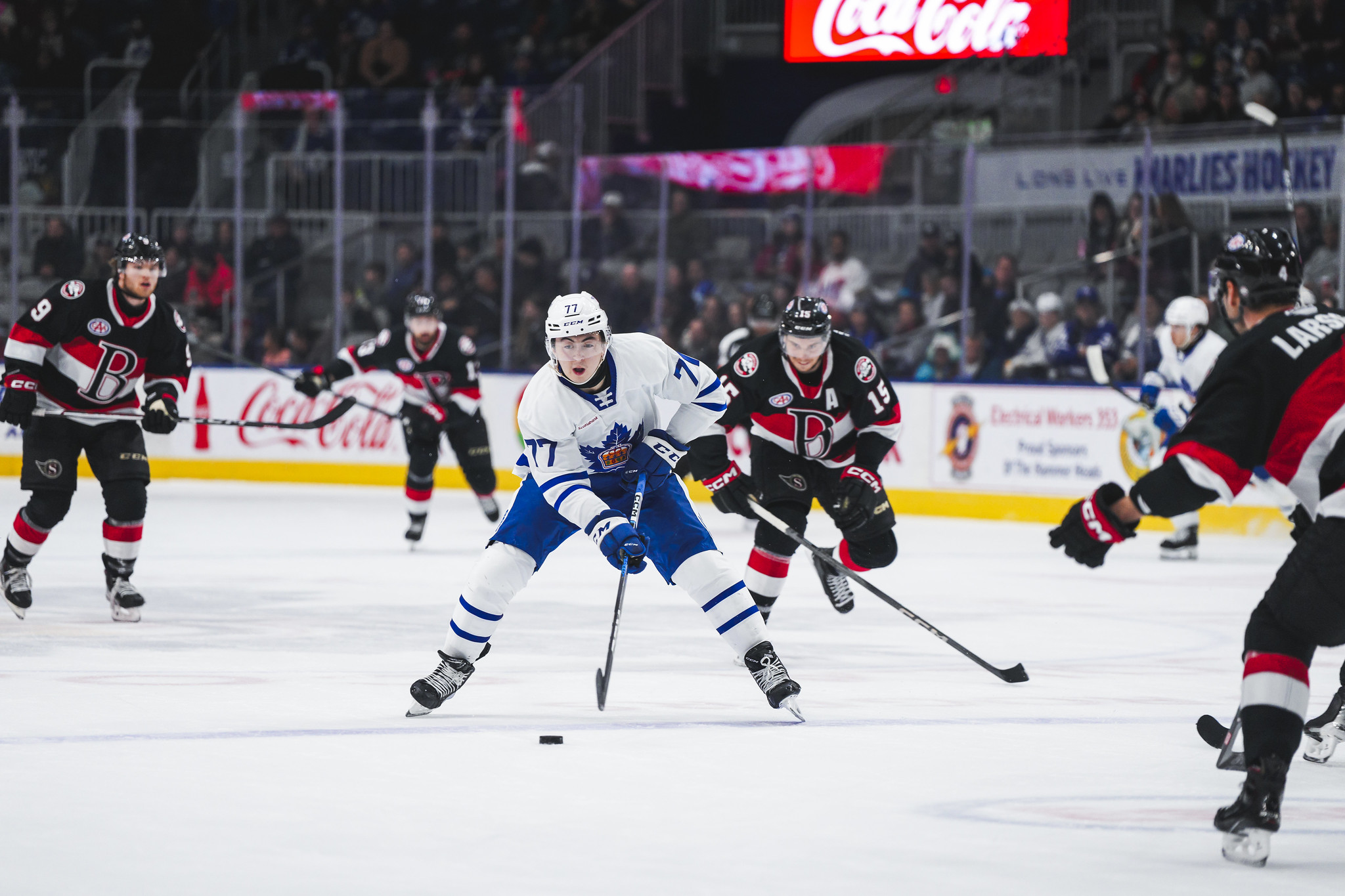
A
Alex Steeves 18G/19A/37P in 36 GP)
The incredible franchise-record-setting 16-game point streak Steeves strung together earlier in the season showcased everything well he does offensively. He’s at his best when simplifying his game with a shoot-first mentality, which also produces ample opportunities for his linemates.
A shooting percentage of 17.3% is likely to dip, but it speaks to his selectivity with his shot and his finishing skill. Steeves’ five-on-five production has slowed of late, but it isn’t too surprising given his linemates have been Dylan Gambrell and Kyle Clifford. He is Toronto’s leading scorer, ranks 11th in the American League in goals, and is set to break previous single-season career highs (23G/51P).
Topi Niemelä (6G/19A/25P in 39 GP)
It was a sink-or-swim situation for Topi Niemelä at the beginning of this season. Receiving top-pairing minutes, Niemelä has thrived with the extra responsibility and ice time and has been by far the calmest and in-control blue-liner on the Marlies’ roster.
The coaching staff withheld Niemelä from select games early in the season to allow time for extra gym sessions to bulk up and build his physical strength. Niemelä continues to impress in facets of his game we know all he’s good at — namely, gap control, footwork to evade pressure, and moving the puck. He’s also adept at choosing his moments to pinch or join a rush in transition.
A-
Dennis Hildeby (.914 SV%, 2.30GAA, 4SO in 22 GP)
It’s been a challenging but overall successful first half of the season for Hildeby. He’s established himself as the Marlies’ number one thanks to both his own level of performance and the injury to Joseph Woll.
Positioning and tracking — allied with his obvious physical assets — have been a feature of the 6’7 netminder’s success. Hildeby gives up very few rebounds when dialed in, which has been his calling card in all four shutouts.
Joseph Blandisi (11G/25A/36P in 40 GP)
Blandisi is the hockey equivalent of a Swiss army knife for the Marlies. He’s capable in a top-six or bottom-six role and on both special teams. Blandisi ranking second in team scoring at this stage of the season isn’t something I would’ve predicted, but he is just three points shy of equalling his single-season career high in points.
The Ontario native has thrived on the penalty kill with his aggressiveness hounding pucks and his willingness to lay his body on the line. His only shortcoming has been a tendency to take a few too many silly penalties, with emotions sometimes getting the better of him. Otherwise, he’s been a fantastic older pro on the team.
Robert Mastrosimone (4G/5A/9P in 30 GP)
Mastrosimone has been forced to wait his turn. He was in and out of the lineup to begin the season, with no clear role assigned to him. The rookie understandably took some time to find his feet, but he is now flying on a fourth line that has created an identity and a purpose.
Mastrosimone is the sparkplug that drives the majority of the offense for the bottom unit, which has borne fruit in the last five games (3G/2A). There is a reason Detroit selected him 54th overall in 2019, and there is likely more to come from his game. I wouldn’t be surprised if we see him higher in the lineup at some point as the season progresses.
B+
Josiah Slavin (6G/9A/15P in 40 GP) & Zach Solow (6G/8A/14P in 36 GP)
It feels natural to pair these two seeing as they’ve almost been joined at the hip this season. Each has spent time higher up the lineup on occasion with varying success. Now permanently united on a line with Mastrosimone, both are playing their best hockey of the campaign. Both have earned the trust of the head coach, who has often put the fourth line out in key situations or immediately following a goal.
B
Logan Shaw (16G/14A/30P in 38 GP)
The performances of Toronto’s captain are difficult to weigh up this season. He hasn’t been the same dynamic player on the ice as last season when he scored at a point-per-game pace. It would not surprise me if we find out he’s been playing through a nagging injury. He’s still been reasonably productive — fifth in team even-strength scoring and third in power-play production — hence a B grade.
Maxime Lajoie (2G/15A/17P in 31 GP)
Good or bad, Lajoie is always noticeable on the ice, and there’s rarely anything in between with him. He’s helped provide some much-needed offense from the blue line. Lajoie is what I expected in terms of his offense outweighing his defensive deficiencies. The Marlies could use a lot more of the former in the second half of the season.
William Villeneuve (1G/13A/14P in 30 GP)
The less you notice Villeneuve, the better. He’s often guilty of trying to do too much or second-guessing himself. When he flicks the switch and plays with pace and confidence instead of hesitance, the game appears easy to him. The inconsistency in that department is what’s holding him back from taking the next step. He’s been solid if unspectacular.
Kyle Clifford (8G/9A/17P in 31 GP)
I’ll never get fully on board with deploying Clifford as a fixture in the top six or on the power play, but it’s unfair of me to downgrade the player based on usage, which isn’t his fault. Clifford has performed well on the PK, and when he sticks to basics at five-on-five, he is reasonably effective.
Mikko Kokkonen (3G/6A/9P in 37 GP)
I toyed with giving Kokkoken a B-, but that would have been a little unjustified. He began the campaign on the first pairing and has since bounced around in the top four with different partners. He continues to play a steady and unspectacular game, although his average skating ability has seen him caught out a few times this season.
B-
Dmitri Ovchinnikov (7G/2A/9P in 19 GP)
Ovchinnikov is Toronto’s unicorn. He’s played in just 50% of the games this season and has been spectacular at times, but he’s not easy to assess due to a truncated campaign. He’s capable of producing offense in bursts as he showed against Grand Rapids with four goals in two games. The Russian forward has to find a way to stay healthy, earn enough trust to remain in the lineup, and establish more consistency on a game-to-game basis.
Max Ellis (3G/10A/13P in 31 GP)
Ellis appeared to be on the verge of a breakout season after recording six points in his first eight games. Since then, he’s struggled to find consistency in his performances. His speed is undoubtedly a weapon and he has good offensive instincts, but at times he needs to be harder on the puck.
Nick Abruzzese (8G/23A/31P in 41 GP)
In his sophomore year, Abruzzese’s season has been somewhat frustrating. The ability to pick a pass and unlock defenses remains an obvious strength, but the other side of the puck presents some concerns. It’s an area he needs to improve and can improve with better decision-making for the most part. Abruzzese could stand to shoot the puck a little more as opponents are aware of his pass-first tendencies. It’s not as if his shot isn’t a weapon when utilized.
Marshall Rifai (1G/8A/9P in 29 GP)
Noted for his physicality and no-nonsense approach last season, including a willingness to drop the gloves, Rifai hasn’t played with the same intensity this year. Some of that might be due to health as the 25-year-old has missed a chunk of time with an injury. He’s another player from whom I will be expecting better performances in the second half of the campaign.
Cameron Gaunce (0G/3A/3P in 16 GP)
Gaunce has been noticeably missing a step since being signed in mid-December. He’s played a lot of hockey in a short span, and the All-Star break may have come at the perfect time for him. Gaunce is a veteran who I’m sure will bounce back in the second half of the season.
Keith Petruzzelli (.875SV% 3.20GAA in 22 GP)
Petruzzelli played only six games through the first two months of the season, and at no point has he found a groove in his game. He’s been guilty of overplaying shots of late and has been susceptible to wraparounds. Time will tell if it’s due to a lack of rhythm or a deficiency creeping into his game.
C +
Dylan Gambrell (6G/16A/22P in 40 GP)
Gambrell is one of the biggest disappointments this season given his previous success at this level. I’ve been stunned by how poor his finishing has been; the phrase “stone hands” wouldn’t adequately capture the struggles in front of the net this season. He scored once through the first 16 games of the campaign and failed to score on the recent nine-game road trip.
C
Tommy Miller (1G/4A/5P in 37 GP)
Miller shows on occasion why the coaching staff likes him so much. He can be strong along the boards winning battles, and he is willing to put his body on the line. But he struggles with his decision-making, gap control, and foot speed.
Matteo Pietroniro (1G/2A/3P in 23 GP)
You cannot fault the effort or attitude of Pietroniro, who plays a physical brand of defense. In the same mold as Miller, his decision-making is a large fault in his game.











